Case study
Haribo, a gummy candy company founded in 1920 in Germany, currently supplies products to 105 countries worldwide and produces over 100 million gummy candies daily. However, Haribo faced a challenge as Muslims and Jews could not consume their products due to the pork-based gelatin used in production. To resolve this issue, after four years of research, they developed a new product using a bacteria-based compound and obtained kosher and halal certifications, making their products accessible to consumers with religious dietary restrictions.
This case demonstrates the importance of culture in international business. For successful global operations, companies must consider various factors including language, climate, business culture, and political situations of each country, with understanding and respecting cultural differences being particularly crucial.
1. Understanding Culture and Its Importance in Business
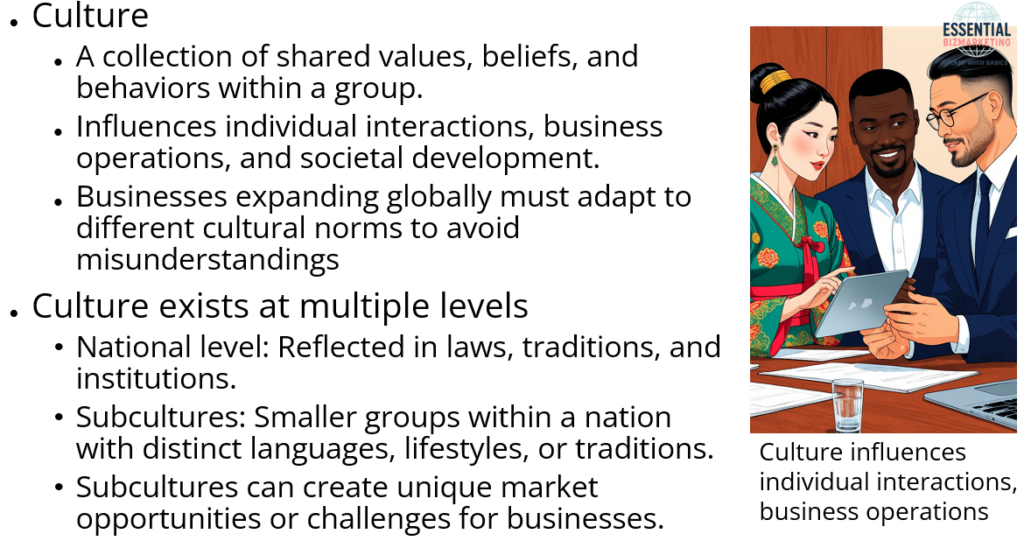
Culture is a collection of shared values, beliefs, and behaviors within a group of people. It determines how individuals interact, how businesses function, and how societies develop. When businesses expand globally, they must recognize and adapt to different cultural norms to avoid misunderstandings and establish strong relationships.
Culture exists at multiple levels. At the national level, a country’s dominant culture is often reflected in its laws, traditions, and institutions. However, within every nation, smaller groups with distinct languages, lifestyles, or traditions—known as subcultures—can significantly influence business practices. Companies need to be aware of these subcultures because they can create unique market opportunities or challenges.

One major challenge businesses face is ethnocentrism, the belief that one’s own culture is superior to others. This mindset can lead to poor business decisions and failed international ventures. Instead, businesses should aim to develop cultural literacy, which is the ability to understand and effectively work within a different cultural context. By being culturally literate, companies can improve their global operations, strengthen customer relationships, and make informed strategic decisions.
2. Values, Attitudes, and Behaviors in Different Cultures
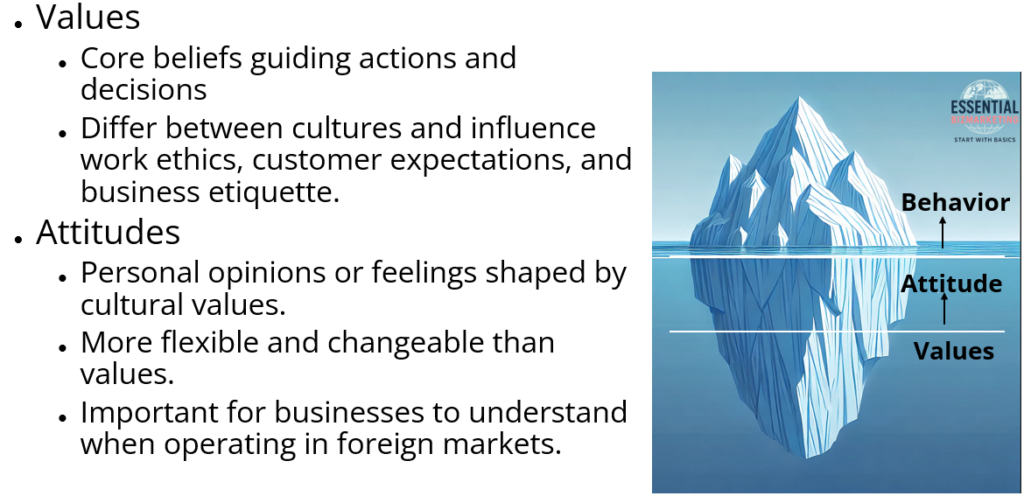
Values are core beliefs that guide people’s actions and decisions. They include concepts such as honesty, respect, and responsibility. Since values differ between cultures, they significantly influence work ethics, customer expectations, and business etiquette.
Attitudes, on the other hand, are personal opinions or feelings shaped by cultural values. While values tend to remain stable over time, attitudes can change more easily. Understanding both values and attitudes is crucial for businesses that want to operate successfully in foreign markets.

Culture also dictates what behaviors are considered appropriate. Manners refer to the proper way to act in social and business situations. For example, in the United States, it is common to discuss business over meals, whereas in Mexico, bringing up business during a meal can be considered impolite unless the host initiates the topic. Customs, which are traditions passed down through generations, also play an important role. An example is Japan’s coming-of-age ceremonies, which celebrate young adults when they reach a certain age. Businesses that understand these cultural behaviors can navigate international interactions more effectively.

The diagram illustrates how social values are internalized by individuals and ultimately shape their behaviors. In collectivist cultures, group goals are considered more important than individual goals, emphasizing the significance of collective success and cooperation.
This value is reinforced through education, where schools teach individuals why prioritizing the group’s goal is essential. As a result, people gradually accept this belief as part of their personal values, integrating it into their own worldview.
Over time, they develop a positive attitude toward the idea, favoring and supporting the notion that working toward the group’s success is both beneficial and meaningful. Eventually, these internalized values and attitudes manifest in actual behavior, leading individuals to actively work for collective goals, often placing them above their personal ambitions.
This process highlights the way cultural values are transmitted through education, internalized as personal beliefs, and ultimately expressed through behavior, shaping the way individuals function within a society.
3. The Role of Social Structure and Education in Culture
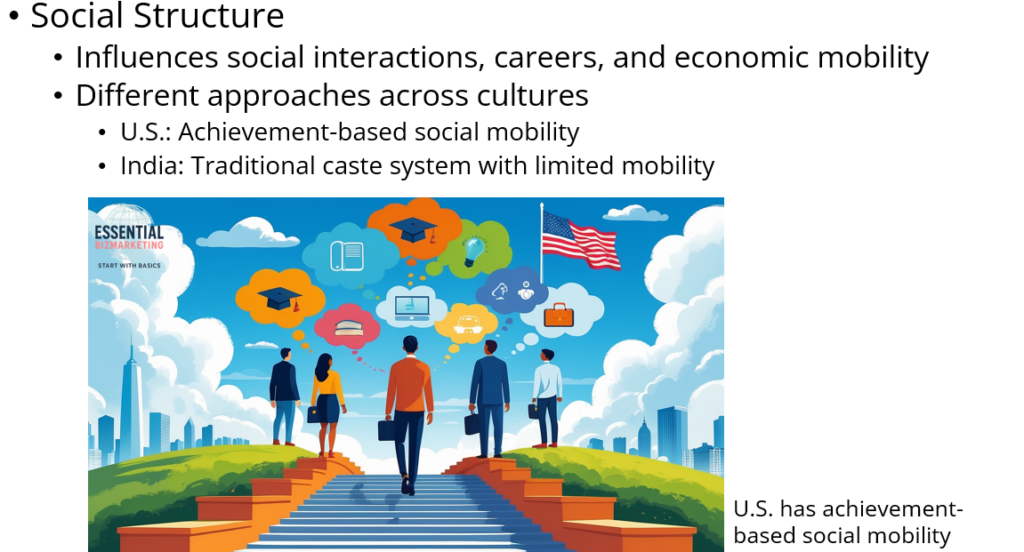
Every society is structured in a way that influences social interactions, career opportunities, and economic mobility. Some cultures, such as the United States, allow people to move between social classes based on their achievements, a concept known as social mobility. In contrast, other cultures have rigid social structures that limit upward mobility. India’s caste system, for example, traditionally assigned individuals to specific social roles from birth, making it difficult to change their economic status.

Education plays a crucial role in shaping culture because it helps pass down traditions, values, and essential skills. Countries with strong education systems tend to have highly skilled workforces, which attract better economic opportunities. However, in some developing nations, highly educated individuals may leave their home country to seek better jobs elsewhere, a phenomenon known as brain drain. This can create long-term challenges for the economic development of those countries.
4. Religion’s Influence on Business
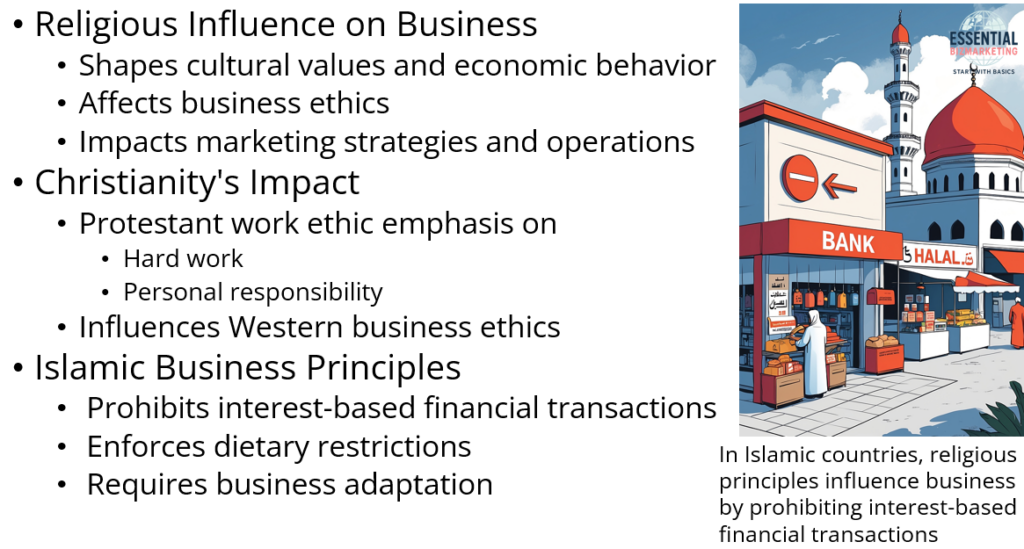
Religious beliefs shape cultural values, ethics, and even economic behavior. Christianity, for example, has influenced Western business ethics, particularly through the Protestant work ethic, which emphasizes hard work and responsibility. In Islamic countries, religious principles affect business in various ways, such as banning interest-based financial transactions and enforcing strict dietary laws.

Hinduism, the dominant religion in India, discourages materialism and adheres to a caste system that influences workplace hierarchies and consumer behavior.
Different religions also impact marketing strategies, work schedules, and product offerings. For instance, Jewish religious laws require that certain foods be kosher, meaning businesses selling food must ensure their products meet these requirements. Similarly, many Hindus avoid eating beef, which affects the food industry in India. Companies operating in religiously diverse markets must respect these beliefs and adapt their strategies accordingly.
5. Communication in International Business

Effective communication is vital in international business, as misunderstandings can lead to lost opportunities or damaged relationships. Spoken language is the most obvious barrier, but even people who share a language may have different ways of expressing ideas. For instance, some cultures favor direct communication, while others rely on subtle, indirect messaging.
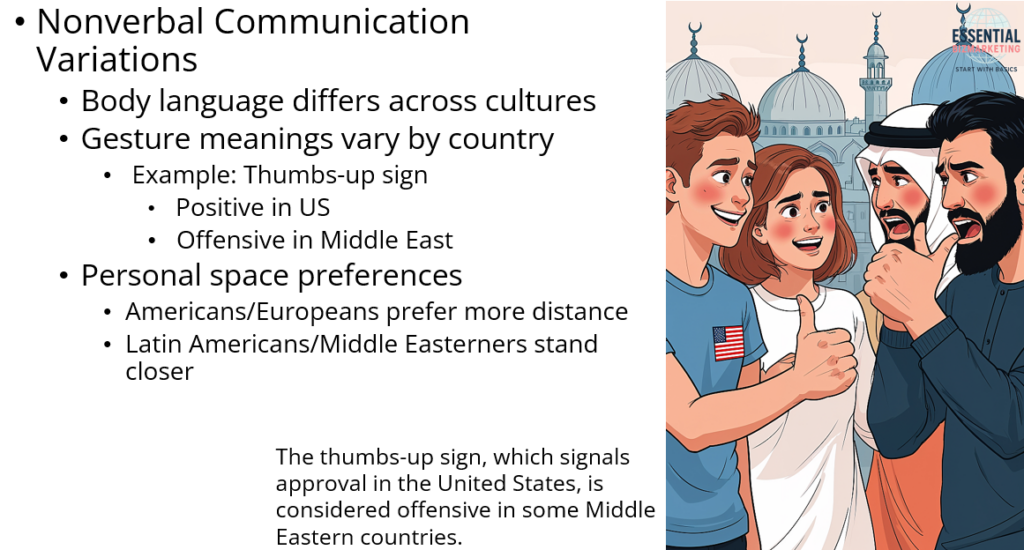
Nonverbal communication, such as body language and gestures, also varies across cultures. A simple hand gesture in one country may have a completely different meaning elsewhere. For example, the thumbs-up sign, which signals approval in the United States, is considered offensive in some Middle Eastern countries. Personal space expectations also differ; while Americans and Europeans often maintain a comfortable distance while speaking, people in Latin American or Middle Eastern cultures may stand much closer.

English is often used as a lingua franca, or common business language, in global trade. However, businesses must still be cautious when translating marketing materials or contracts, as poor translations can lead to costly mistakes. Some companies have made major errors when translating advertising slogans into foreign languages, leading to confusion or even offense.
6. Culture and Business in the Workplace

Culture influences how businesses operate, how employees work, and how people perceive time and efficiency. In some cultures, time is viewed as strict and structured. Countries like the United States and Japan prioritize punctuality, efficiency, and long working hours. In contrast, cultures in Latin America and the Mediterranean tend to have a more relaxed approach to time, emphasizing relationships over rigid schedules.
Cultural norms also affect workplace behavior. In individualistic cultures, such as the United States, employees are encouraged to take initiative and are rewarded for personal achievements. In collectivist cultures, such as China, teamwork and group harmony are more valued than individual success.
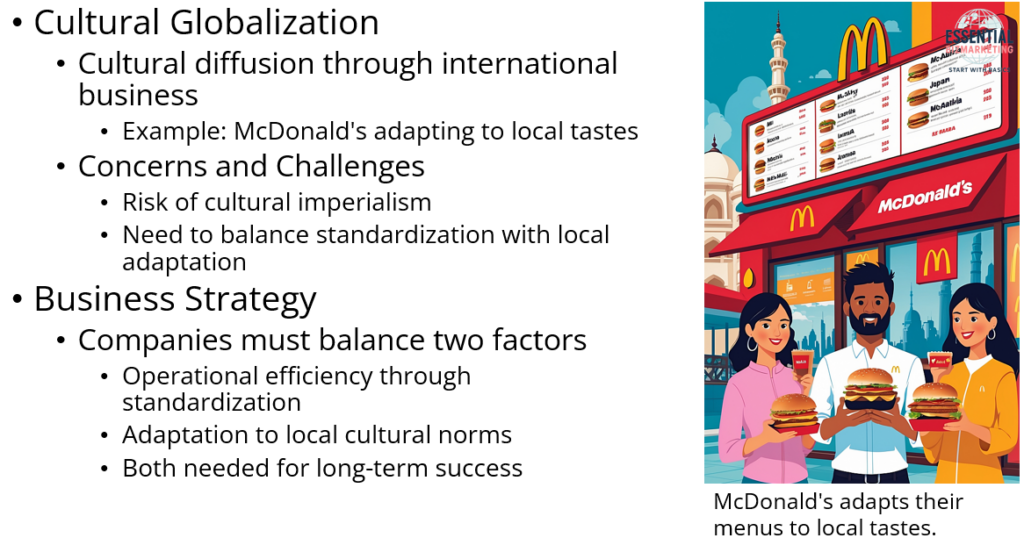
Additionally, globalization has led to cultural diffusion, where cultural traits spread from one society to another. International companies play a major role in this process. For example, American fast-food chains like McDonald’s adapt their menus to local tastes while still spreading aspects of Western food culture. Some critics argue that this leads to cultural imperialism, where foreign businesses overshadow local traditions. Companies must balance standardizing their operations for efficiency while also adapting to local cultures to ensure acceptance and long-term success.
7. Comparing Cultures: Key Theoretical Frameworks
Hofstede Framework and Cultural Dimensions (Link)
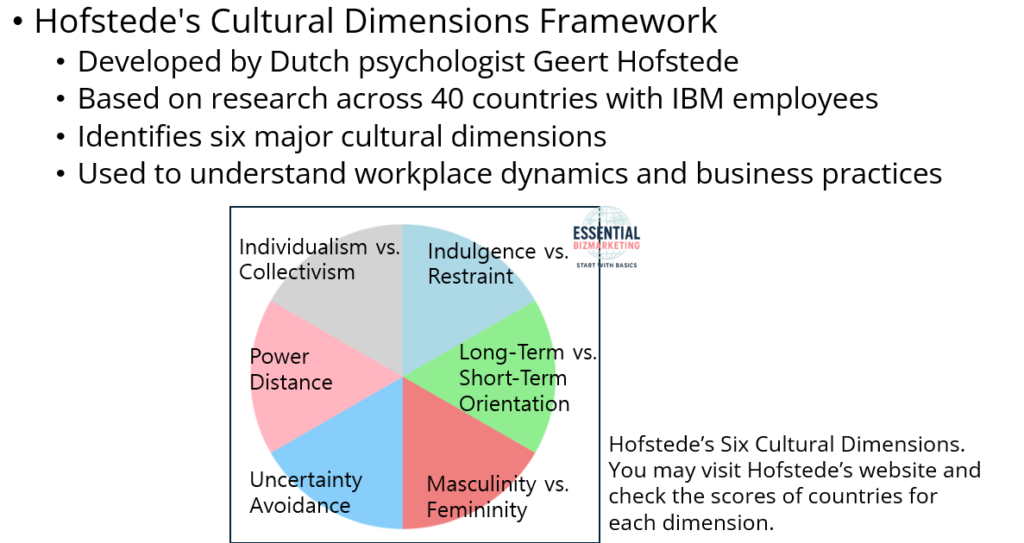
Dutch social psychologist Geert Hofstede developed a framework to compare cultures based on key differences in values and behaviors. His research, initially conducted with IBM employees across 40 countries, identified six major cultural dimensions that explain how people from different societies think and act.

These dimensions provide insights into workplace dynamics, leadership styles, and decision-making processes in international business. You can compare countries by each dimension score on The Culture Factor (Link)
Individualism vs. Collectivism
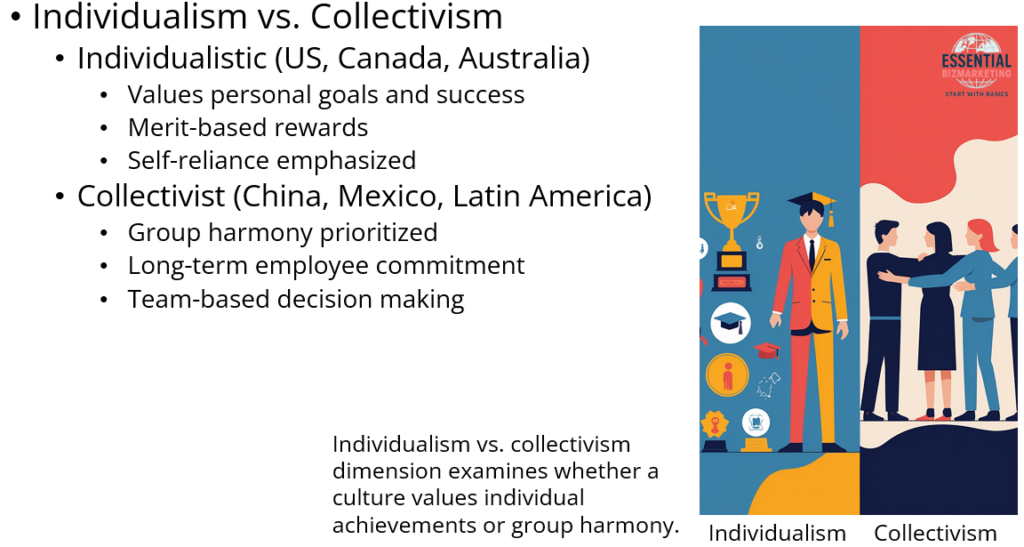
This dimension examines whether a culture values individual achievements or group harmony.
- Individualistic cultures, such as the United States, Canada, and Australia, emphasize personal goals, self-reliance, and individual success. People are expected to take care of themselves and their immediate family rather than relying on a larger community. In business settings, promotions and rewards are often based on personal performance rather than team contributions.
- Collectivist cultures, such as China, Mexico, and many Latin American countries, prioritize group loyalty and social harmony. Decisions are made with the well-being of the group in mind, whether it be family, workplace teams, or society as a whole. Employees in collectivist societies often expect lifelong commitments from employers and may feel uncomfortable with highly competitive work environments.
Understanding this dimension helps businesses adjust their management styles. For instance, in individualistic cultures, companies may use merit-based promotions and encourage independent decision-making. In contrast, in collectivist cultures, teamwork, consensus-building, and long-term relationships with employees and business partners are more valued.
Power Distance

Power distance refers to how much a society accepts hierarchical structures and unequal distributions of power.
- High power distance cultures, such as Mexico, India, and Russia, accept clear distinctions between authority figures and subordinates. People in these cultures tend to respect hierarchy, and employees are less likely to challenge their supervisors. Organizations in these societies often have centralized decision-making, with leadership positions held by a select few who wield significant influence.
- Low power distance cultures, such as Sweden, Denmark, and the Netherlands, favor egalitarianism. Employees are more likely to question authority, and decision-making is more decentralized. These cultures encourage open communication between managers and employees, and hierarchy is less rigid.
For businesses, recognizing power distance is essential when structuring organizations and managing employees. In high power distance cultures, companies may need to establish clear lines of authority and respect formalities. In low power distance cultures, a more collaborative and inclusive approach to decision-making is expected.
Uncertainty Avoidance

This dimension measures how comfortable a culture is with ambiguity, change, and risk.
- High uncertainty avoidance cultures, such as Japan, Greece, and Portugal, prefer clear rules, stability, and predictability. These societies tend to have strict laws, well-defined social norms, and a lower tolerance for taking risks. Employees in these cultures value job security, detailed instructions, and structured environments.
- Low uncertainty avoidance cultures, such as the United Kingdom, Singapore, and Denmark, are more comfortable with ambiguity and change. These societies are more open to innovation, flexible work arrangements, and risk-taking in business. People tend to be adaptable and willing to try new approaches without requiring rigid guidelines.
Businesses operating in high uncertainty avoidance cultures may need to provide extensive training, detailed contracts, and structured work environments to ensure employees feel secure. In low uncertainty avoidance cultures, companies can encourage experimentation and flexibility in decision-making.
Masculinity vs. Femininity

This dimension explores whether a society values competitiveness and assertiveness (masculinity) or cooperation and quality of life (femininity).
- Masculine cultures, such as Japan, the United States, and Germany, prioritize success, ambition, and material rewards. People in these cultures tend to be driven by competition and career advancement. Workplaces may emphasize long hours, performance-based rewards, and aggressive marketing strategies.
- Feminine cultures, such as Sweden, Norway, and the Netherlands, focus on well-being, work-life balance, and caring for others. These societies value modesty, social support systems, and equality. Work environments in feminine cultures tend to be more collaborative, and success is often measured by overall life satisfaction rather than financial gain.
Companies must adapt their business strategies based on this dimension. In masculine cultures, marketing messages that emphasize success, ambition, and competition tend to be more effective. In feminine cultures, brands that highlight social responsibility, sustainability, and work-life balance may be better received.
Long-Term vs. Short-Term Orientation

This dimension examines whether a culture focuses on future rewards or values traditions and immediate results.
- Long-term oriented cultures, such as China, South Korea, and Germany, emphasize persistence, thrift, and planning for the future. These cultures value education, innovation, and long-term business strategies. People in these societies are more willing to delay gratification to achieve long-term success.
- Short-term oriented cultures, such as the United States, the Philippines, and Nigeria, focus on immediate results, traditions, and fulfilling social obligations. These societies tend to prioritize quick returns on investment and short-term goals over long-term planning.
Businesses must recognize these preferences when entering new markets. In long-term oriented cultures, building relationships and investing in sustainable growth is crucial. In short-term oriented cultures, companies should focus on quick wins and delivering immediate value to customers.
Indulgence vs. Restraint

This dimension evaluates how much a culture encourages people to enjoy life and freely express their desires.
- Indulgent cultures, such as the United States, Mexico, and Brazil, promote personal happiness, leisure, and enjoyment. People in these cultures value freedom of speech, fun activities, and a positive outlook on life. Businesses in these societies often market products that enhance personal pleasure and lifestyle.
- Restrained cultures, such as Russia, China, and Pakistan, exercise greater control over desires and personal expression. These cultures emphasize discipline, strict social norms, and a sense of duty over personal enjoyment. Public displays of joy or leisure may be less common, and societies place a higher value on hard work and self-restraint.
For businesses, understanding this dimension is key when developing marketing strategies. In indulgent cultures, advertising may focus on enjoyment, relaxation, and luxury. In restrained cultures, businesses may need to align their messages with values such as responsibility, tradition, and community well-being.
How Businesses Use the Hofstede Framework
The Hofstede framework provides a valuable tool for businesses to navigate cultural differences. By analyzing these six dimensions, companies can adjust their management styles, marketing strategies, and customer engagement practices to better fit the cultural expectations of different markets. Whether expanding into a new country, hiring international employees, or negotiating deals, understanding cultural dimensions can significantly improve business success.
8. Conclusion
Culture plays a critical role in shaping international business practices. Companies that want to succeed in global markets must understand how values, behaviors, religion, communication, and workplace norms differ across cultures. By developing cultural literacy and adapting business strategies to local traditions, businesses can build better relationships, avoid costly mistakes, and expand successfully into new markets.
Related videos
- How to Navigate Cultural Differences in Business (MIT Sloan, 2020)
- Chinese Business Etiquette in Africa (CNN Marketplace Africa, 2019)
- Nigeria Will Lead $7.7 Trillion Global Halal Market – VP Shettima (2024)
- Title: YouTube – Arise News
- Why Culturally-Diverse Women Are Being Held Back in the Workplace (ABC News Australia, 2022)
- Title: YouTube – ABC News
- Why McDonald’s Flopped In Vietnam
- Title: Youtube – CNBC
- Why KFC Can’t Compete With McDonald’s In Israel
- Title: Youtube – CNBC
- Why Walmart Failed In Brazil?
- Title: Youtube – CNBC
📚 References
Wild, J. J., & Wild, K. L. (2019). International business: The challenges of globalization (9th ed.). Pearson.
📁 Start exploring the Blog
📘 Or learn more About this site
🧵 Or follow along on X (Twitter)
🔎 Looking for sharp perspectives on global trade and markets?
I recommend @GONOGO_Korea as a resource I trust and regularly learn from.
